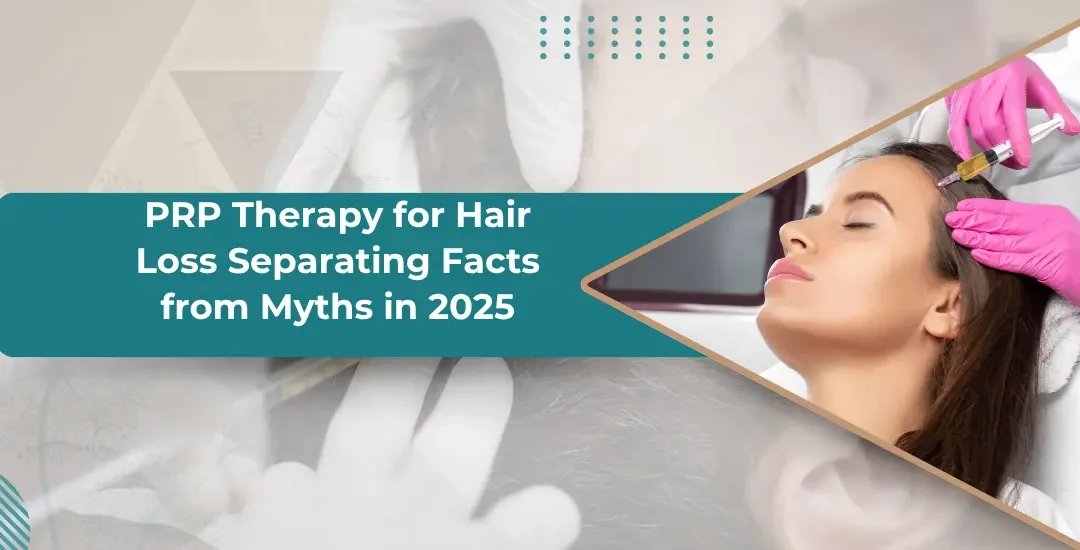Hair loss treatments have seen a surge in innovation, but one therapy that continues to spark both hope and confusion is PRP—Platelet Rich Plasma. PRP therapy for hair loss in 2025 remains one of the most talked-about solutions in dermatology. At Dr. Swetha’s Cosmoderm Centre, a leading hair and skin clinic in Indiranagar, Bangalore, cutting-edge techniques are transforming how patients approach hair regrowth.
“Hair loss is personal. A treatment plan that truly works must be evidence-based, customized, and transparent about results,” says Dr. Swetha, a dermatologist in Indiranagar, known for her expertise in regenerative therapies.
What Exactly Is PRP and How Does It Work?

PRP, or platelet rich plasma hair treatment is a regenerative procedure that uses the healing components of your blood to stimulate hair growth. A small amount of blood is drawn, spun in a centrifuge, and separated to isolate plasma rich in growth factors and platelets.
This plasma is then injected into targeted areas of the scalp where thinning is evident. The idea is that these platelets stimulate dormant hair follicles, improve blood flow, and prolong the hair growth (anagen) phase.
In 2025, PRP sessions have become more sophisticated, with customized protocols involving growth factor boosters, micro-needling, and stem cell injection for hair growth in some advanced cases.
The Evidence in 2025—Does PRP Really Regrow Hair?

Studies over the last decade have consistently shown promising outcomes for PRP. As of 2025, multiple meta-analyses and clinical trials suggest that platelet rich plasma for hair regrowth can:
- Increase hair density and thickness
- Slow down the rate of hair loss
- Improve hair shaft quality
However, results vary depending on individual response, severity of hair loss, and treatment consistency. For those with early to moderate androgenetic alopecia, PRP hair treatment works best. When combined with treatments like low-level laser therapy or minoxidil, it performs even better.
Myth-Busting—Common Misconceptions
Myth 1: PRP gives instant results.
Reality: It takes time. Noticeable results typically begin after 3 sessions, spaced 4–6 weeks apart.
Myth 2: It regrows hair on completely bald spots.
Reality: PRP is not effective in areas with no follicles. It can thicken thinning areas but won’t generate new follicles.
Myth 3: PRP is just a trend.
Reality: It’s been used for years in orthopedics and dermatology. PRP is evidence-backed, especially when part of a holistic plan.
Myth 4: One session is enough.
Reality: PRP is a protocol, not a one-off. Maintenance treatments are crucial for lasting results.
Who Is (and isn’t) a Good Candidate in 2025?

Ideal Candidates
- Men and women with early-stage hair thinning
- Patients with androgenetic alopecia
- Individuals looking for natural, drug-free options
- Women experiencing postpartum shedding (PRP for hair loss in women has shown impressive results)
Not Ideal Candidates
- People with complete baldness (PRP treatment for baldness has limited scope)
- Individuals with underlying platelet disorders or blood diseases
- Those unwilling to commit to multiple sessions
Step-by-Step Procedure at Dr. Swetha’s Cosmoderm Centre

Here’s how PRP therapy is done at the clinic:
Initial Consultation
Detailed hair analysis and scalp mapping are done to determine suitability.
1. Blood Draw and Separation
Around 10-20 ml of your blood is taken and centrifuged to separate the plasma rich platelets.
2. Scalp Numbing
A topical anesthetic is applied to reduce discomfort.
3. Microinjections
Using fine needles, the platelet rich plasma is injected into thinning areas.
4. Post-Care Guidance
You are advised on aftercare including hair washing, sun exposure, and follow-up timelines.
Each session takes about 60 minutes. A course usually includes 4–6 sessions, with boosters every 6 months.
PRP vs Other 2025 Hair-Restoration Options
|
Treatment |
Invasiveness |
Results Timeline |
Maintenance |
Cost (Approx.) |
|
PRP Therapy |
Low |
2–4 months |
Yes |
₹5,000–₹15,000/session |
|
Hair Transplant |
High |
6–12 months |
No |
₹70,000–₹1.5 lakh or more |
|
Minoxidil/Finasteride |
Low |
3–6 months |
Continuous |
₹500–₹1500/month |
|
Stem Cell Injection for Hair Growth |
Moderate |
2–5 months |
Occasional |
₹30,000–₹70,000 per session |
|
Plasma Rich Hair Treatment (Advanced) |
Moderate |
2–3 months |
Yes |
₹15,000–₹30,000/session |
PRP strikes a balance between safety, natural results, and affordability—especially appealing to those not ready for surgery.
Expected Results & Timeline
- Month 1: Reduced hair shedding
- Month 2–3: Visible thickening in treated areas
- Month 4–6: Fuller density and healthier texture
- Beyond 6 months: Maintenance sessions optimize and sustain the outcome
Consistency is key. PRP is not a magic wand but a long-term investment in your hair health.
Takeaway—Is PRP Worth It in 2025?
Frequently asked question.
How many PRP sessions are needed for hair loss?
Most patients require 4–6 sessions spaced 4–6 weeks apart, followed by maintenance every 6 months.
Is PRP therapy safe?
Yes. Since it uses your blood, there’s minimal risk of allergic reactions. Side effects are generally mild and temporary.
Does PRP regrow completely bald areas?
No. PRP works best where there are existing follicles. It thickens and revitalizes, but doesn’t generate new follicles.
How quickly will I see results?
Results generally appear between 2 to 4 months, with continued improvement over a year.
Does PRP hurt?
Discomfort is minimal. A numbing cream is applied beforehand to ease the experience.
How long do PRP results last?
With regular maintenance sessions, results can be sustained for years.
Can women get PRP for hair loss?
Absolutely. PRP for hair loss in women is effective for conditions like female pattern baldness and postpartum shedding.
What’s the difference between PRP and PRF?
PRF (Platelet Rich Fibrin) is a newer version with a more sustained release of growth factors, but PRP remains more widely used and studied in hair regrowth.
Reference
https://pmc.ncbi.nlm.nih.gov/articles/PMC4134641/
https://www.healthline.com/health/prp-for-hair-loss
Disclaimer: The information shared in this content is for educational purposes only and not for promotional use.


